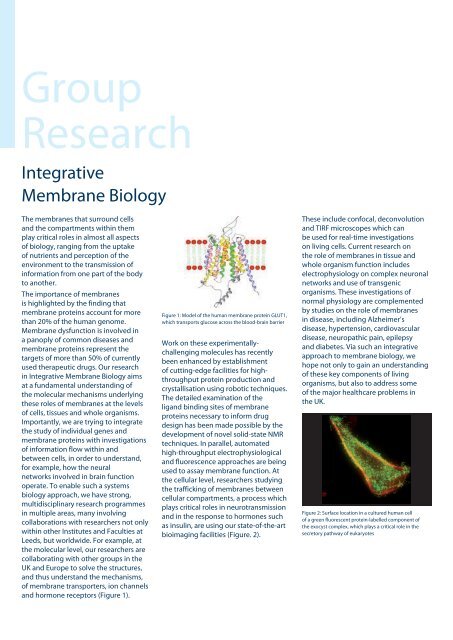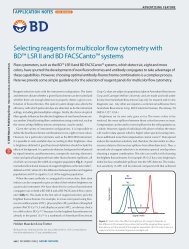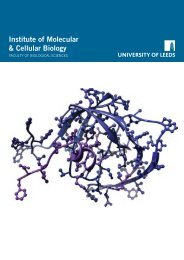Institute of Membrane & Systems Biology - Faculty of Biological ...
Institute of Membrane & Systems Biology - Faculty of Biological ...
Institute of Membrane & Systems Biology - Faculty of Biological ...
Create successful ePaper yourself
Turn your PDF publications into a flip-book with our unique Google optimized e-Paper software.
Group<br />
Research<br />
Integrative<br />
<strong>Membrane</strong> <strong>Biology</strong><br />
The membranes that surround cells<br />
and the compartments within them<br />
play critical roles in almost all aspects<br />
<strong>of</strong> biology, ranging from the uptake<br />
<strong>of</strong> nutrients and perception <strong>of</strong> the<br />
environment to the transmission <strong>of</strong><br />
information from one part <strong>of</strong> the body<br />
to another.<br />
The importance <strong>of</strong> membranes<br />
is highlighted by the finding that<br />
membrane proteins account for more<br />
than 20% <strong>of</strong> the human genome.<br />
<strong>Membrane</strong> dysfunction is involved in<br />
a panoply <strong>of</strong> common diseases and<br />
membrane proteins represent the<br />
targets <strong>of</strong> more than 50% <strong>of</strong> currently<br />
used therapeutic drugs. Our research<br />
in Integrative <strong>Membrane</strong> <strong>Biology</strong> aims<br />
at a fundamental understanding <strong>of</strong><br />
the molecular mechanisms underlying<br />
these roles <strong>of</strong> membranes at the levels<br />
<strong>of</strong> cells, tissues and whole organisms.<br />
Importantly, we are trying to integrate<br />
the study <strong>of</strong> individual genes and<br />
membrane proteins with investigations<br />
<strong>of</strong> information flow within and<br />
between cells, in order to understand,<br />
for example, how the neural<br />
networks involved in brain function<br />
operate. To enable such a systems<br />
biology approach, we have strong,<br />
multidisciplinary research programmes<br />
in multiple areas, many involving<br />
collaborations with researchers not only<br />
within other <strong>Institute</strong>s and Faculties at<br />
Leeds, but worldwide. For example, at<br />
the molecular level, our researchers are<br />
collaborating with other groups in the<br />
UK and Europe to solve the structures,<br />
and thus understand the mechanisms,<br />
<strong>of</strong> membrane transporters, ion channels<br />
and hormone receptors (Figure 1).<br />
Figure 1: Model <strong>of</strong> the human membrane protein GLUT1,<br />
which transports glucose across the blood-brain barrier<br />
Work on these experimentallychallenging<br />
molecules has recently<br />
been enhanced by establishment<br />
<strong>of</strong> cutting-edge facilities for highthroughput<br />
protein production and<br />
crystallisation using robotic techniques.<br />
The detailed examination <strong>of</strong> the<br />
ligand binding sites <strong>of</strong> membrane<br />
proteins necessary to inform drug<br />
design has been made possible by the<br />
development <strong>of</strong> novel solid-state NMR<br />
techniques. In parallel, automated<br />
high-throughput electrophysiological<br />
and fluorescence approaches are being<br />
used to assay membrane function. At<br />
the cellular level, researchers studying<br />
the trafficking <strong>of</strong> membranes between<br />
cellular compartments, a process which<br />
plays critical roles in neurotransmission<br />
and in the response to hormones such<br />
as insulin, are using our state-<strong>of</strong>-the-art<br />
bioimaging facilities (Figure. 2).<br />
These include confocal, deconvolution<br />
and TIRF microscopes which can<br />
be used for real-time investigations<br />
on living cells. Current research on<br />
the role <strong>of</strong> membranes in tissue and<br />
whole organism function includes<br />
electrophysiology on complex neuronal<br />
networks and use <strong>of</strong> transgenic<br />
organisms. These investigations <strong>of</strong><br />
normal physiology are complemented<br />
by studies on the role <strong>of</strong> membranes<br />
in disease, including Alzheimer’s<br />
disease, hypertension, cardiovascular<br />
disease, neuropathic pain, epilepsy<br />
and diabetes. Via such an integrative<br />
approach to membrane biology, we<br />
hope not only to gain an understanding<br />
<strong>of</strong> these key components <strong>of</strong> living<br />
organisms, but also to address some<br />
<strong>of</strong> the major healthcare problems in<br />
the UK.<br />
Figure 2: Surface location in a cultured human cell<br />
<strong>of</strong> a green fluorescent protein-labelled component <strong>of</strong><br />
the exocyst complex, which plays a critical role in the<br />
secretory pathway <strong>of</strong> eukaryotes










